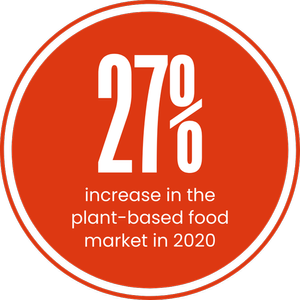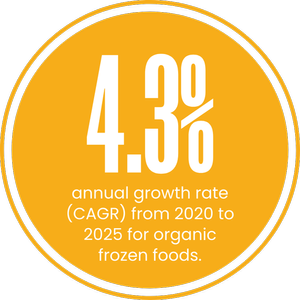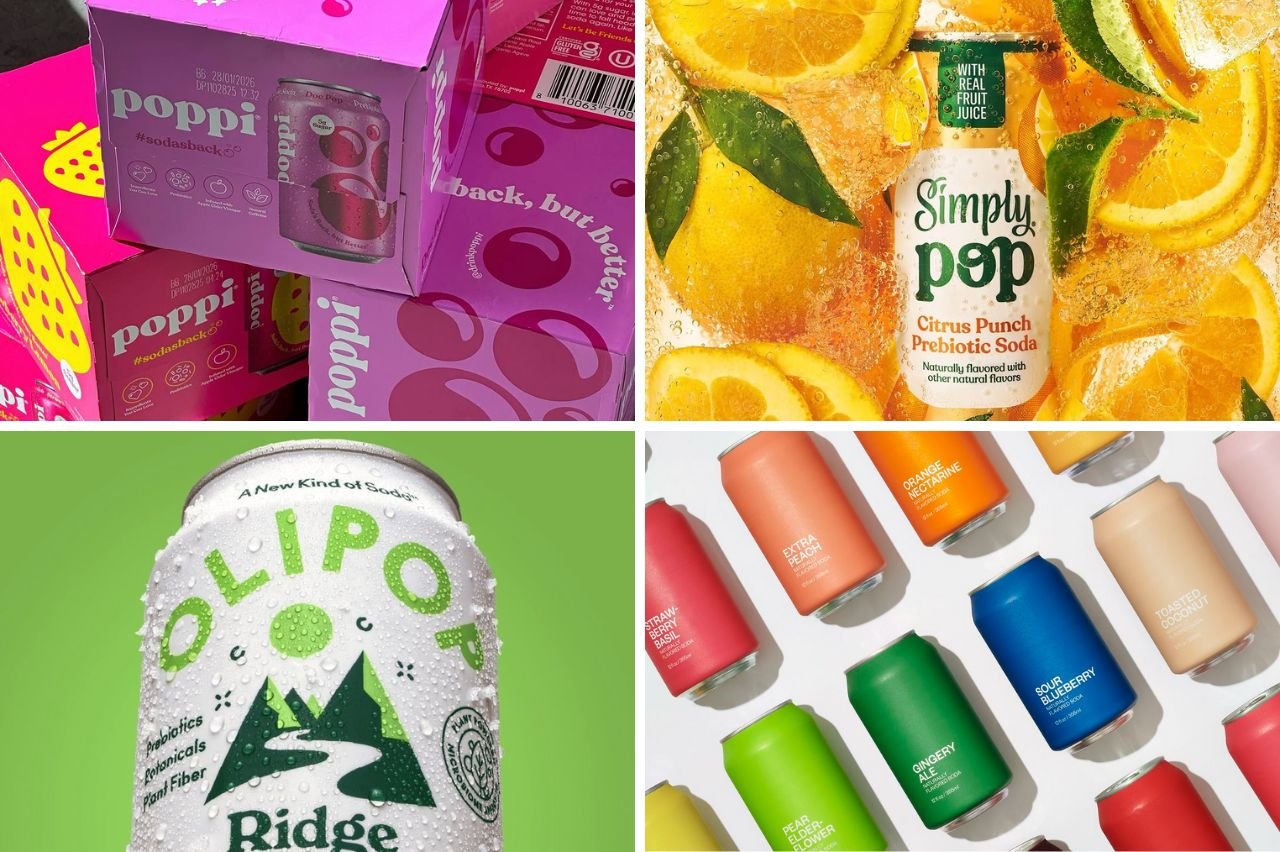Frozen Food Trends: CPG Industry Outlook

Major changes in the frozen food market put spotlights on health, organic products. The frozen foods market has evolved dramatically in recent years. Shifting consumer preferences and technological advancements is driving this change. Put simply: shoppers expect the frozen food products they bring home to do more than taste really good.
In 2024, the frozen food aisle is no longer just a space for quick and convenient frozen meals. It’s become a vibrant sector that caters to diverse dietary needs and culinary preferences.
Here are the key trends shaping the frozen food industry that we’ll explore:
- Plant-based perfection
- Health-first and organic options
- Premium quality foods
- Flavors without borders
Plant-Based Perfection

The growing interest in plant-based diets has led to a surge in vegan and vegetarian frozen meals. But it’s not just vegans and vegetarians driving this trend. It’s true among all convenience food lovers. The market is also appealing to “flexitarians” – individuals who are reducing their meat consumption without eliminating it entirely.
The Good Food Institute reported a 27% increase in the plant-based food market in 2020, illustrating the robust demand for plant-based products. Frozen food manufacturers are capitalizing on this trend by offering a variety of plant-based meals and meat substitutes. This includes everything from plant-based pizzas and entrees to meat options that don’t actually include any meat. The ‘Beyond Meat’ market is hot.
There are few better examples of small food brands building on this sustained trend than Abbot.
Vegan frozen frozen ready meals (and this doesn’t end with frozen vegetables) are a key growth driver in recent years. The availability of high-quality, delicious plant-based frozen foods is expanding consumer choices and catering to a broader audience looking to incorporate more plant-based meals into their diets.
Health-first and organic options

The trend towards better-for-you and organic frozen foods is gaining significant traction, fueled by health-conscious consumers and younger shoppers who prioritize clean eating. This segment of the frozen food market is witnessing a remarkable surge in demand, with products that feature organically sourced ingredients taking center stage.
Don’t believe us? The American Frozen Food Institute backs up the importance of ethical frozen meal options.
A recent report by Mordor Intelligence highlights this trend, showing a compound annual growth rate (CAGR) of 4.3% from 2020 to 2025 for organic frozen foods. This growth is evidence of increasing consumer preferences for foods that are not only convenient but also align with their health and wellness goals.
The shift towards organic frozen foods is part of a broader trend towards healthy eating… And this trend has seeped into the convenience food space. Taste is still an important factor in purchasing decisions, but it’s less important than ever before. Consumers are increasingly seeking frozen meals that are gluten-free, low-carb, high-protein, and feature clean labels. These options reflect a growing demand for foods in the frozen aisle that support specific dietary needs and preferences, making the frozen food aisle a diverse and inclusive space.
Think about how many people can’t eat dairy anymore. Ice cream manufacturers have adapted by bringing lactose-free options to market.
From Freezer to Feast: Enjoying Restaurant-Quality Meals at Home
The upscale section of the frozen food industry is thriving. It’s fueled by the demand for top-notch, convenient, and nutritious options. This trend is powered by health-conscious individuals who seek well-balanced diets… But also value the ease of ready-to-eat meals.
After all, convenience is the driving force behind meaningful change.
The premium frozen food category has greatly benefited from innovations in freezing technology, which maintain the nutritional integrity and flavor of superior ingredients. This advancement allows consumers to relish gourmet dishes at home without sacrificing taste or nutritional benefits. This is true for frozen vegetables, frozen dinners, frozen pizza, frozen dessert and every other frozen product you can think of.
Affluent urban households are leading this trend, propelling the sales of premium frozen items that boast gourmet recipes, ethically sourced ingredients, and creative flavors. This movement aligns with increasing enthusiasm for home cooking and culinary experimentation. The growing popularity of culinary TV shows and social media content is proof of this behavior change.
Now, consumers can savor restaurant-quality meals in their own kitchens and appeal to food enthusiasts who prioritize both quality and convenience.
Around the World in Your Kitchen: Exploring Global Flavors in Frozen Foods

The world is more connected than ever and consumers are embracing culinary exploration. Borders evaporate, which has allowed consumers to be exposed to international flavors and cuisines. This shift is evident in the frozen food landscape, where there is a growing appetite for recipes from Tokyo to Santiago.
The global ethnic flavors food market is growing. It soared from over $47 billion in 2022 to $52 billion in 2023. COVID likely helped as travel was restricted and consumers spent more time trying new dishes to pass the time. This trend extends to the frozen food sector and is marked by a heightened demand for products infused with Mexican, Asian, Indian, and Mediterranean influences.
The growing popularity of global frozen fare is propelled by the quest for swift, hassle-free meal solutions that fit into hectic lifestyles. Consumers crave authentic, ready-to-devour dishes that let them embark on culinary voyages from the comfort of their homes. This phenomenon not only satisfies the palates of adventurous eaters but also signifies a broader societal embrace of culinary diversity.
Convenience Meets Customization: Personalizing Frozen Food Choices
Another emerging trend in the frozen food industry is the increasing demand for personalized food choices. Consumers today are seeking products that not only meet their dietary requirements but also align with their taste preferences and lifestyle choices. This has led to the rise of customizable frozen food options, where consumers can mix and match ingredients to create meals that suit their individual needs.
Meal kit services and subscription-based frozen food deliveries are capitalizing on this trend by offering a variety of customizable options. These services allow consumers to select from a range of ingredients and meal types, catering to specific diets such as keto, paleo, gluten-free, and more.
This level of customization ensures that consumers can enjoy convenient, ready-to-eat meals without compromising on their personal health goals and taste preferences.
Sustainability in Focus: Ethical Sourcing and Eco-Friendly Practices
Sustainability continues to be a crucial factor influencing frozen food trends. Consumers are increasingly concerned about the environmental impact of their food choices, prompting frozen food manufacturers to adopt more sustainable practices. This includes sourcing ingredients from ethical suppliers, reducing carbon footprints, and implementing eco-friendly packaging solutions.
Brands are now highlighting their commitment to sustainability through transparent labeling and certifications, such as Fair Trade and Rainforest Alliance. And this isn’t a ‘nice-to-have’ anymore, it’s a necessity for any CPG brand in the frozen foods industry.
By choosing frozen foods that prioritize ethical sourcing and sustainable practices, consumers can make a positive impact on the environment while enjoying high-quality, convenient meals.
Technological Innovations: Enhancing Quality and Shelf Life
Advancements in freezing technology are also playing a significant role in the frozen food industry. New techniques such as cryogenic freezing and individual quick freezing (IQF) are helping to preserve the texture, flavor, and nutritional value of frozen foods better than ever before. And artificial intelligence is accelerating this change.
These technologies ensure that frozen products maintain their quality over extended periods, providing consumers with fresh-tasting meals that are easy to prepare.
Moreover, smart packaging solutions are emerging, offering features like temperature indicators and QR codes that provide consumers with information about the product’s freshness and sourcing. These innovations enhance the overall consumer experience, making frozen foods a more attractive option for those seeking convenience without sacrificing quality.
As the frozen food industry continues to evolve, these trends indicate a promising future where convenience, health, sustainability, and innovation come together to meet the diverse needs of modern consumers.
The New Landscape in Frozen Foods Marketing
Social media is now the most important marketing channel for frozen foods products. Instagram, Facebook, TikTok, Pinterest and other platforms are more important than traditional advertising and television.
More than ever, consumers know which frozen foods products they’ll buy before they leave the house. They read reviews, watch taste tests and dissect ingredients like never before.
Simply getting on a store shelf isn’t enough anymore. Consumer packaged frozen foods must find success on social media to compete with an increasingly tech-savvy playing field.
We at Firebelly specialize in growing food & beverage brands online. Here’s how we’ve done it.
Reach out if you’re looking ready to grow your CPG frozen food brand.


